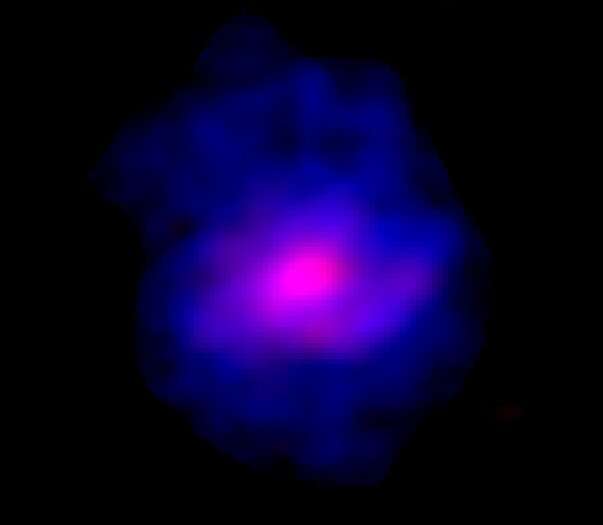Scientists have challenged our current understanding of how galaxies form by unveiling pictures of a young galaxy in the early life of the Universe which appears surprisingly mature.https://dc52961d40a606470db30c0b3de6919f.safeframe.googlesyndication.com/safeframe/1-0-37/html/container.html
The galaxy, dubbed ALESS 073.1, appears to have all of the features expected of a much more mature galaxy and has led the team of scientists to question how it grew so fast.
The new research has been published today in Science.
Galaxies come in a variety of shapes, sizes and colours, and are made up of different components such as rotating disks, spiral arms, and “bulges”.
A major goal of present-day astronomy is understanding why different galaxies look the way they are today and when their different components formed.
Find your dream job in the space industry. Check our Space Job Board »
The team, led by scientists at Cardiff University, used the Atacama Large Millimeter/submillimeter Array (ALMA) telescope as a ‘time machine‘ to peer into the remote past, revealing how ALESS 073.1 looked just 1.2 billion years after the Big Bang.
Because the light emitted from the galaxy took billions of years to reach our telescopes on Earth, the team were able to explore how the galaxy looked during its infancy and determine how it was initially formed.

The result was one of the sharpest, direct images of a primordial galaxy ever produced which allowed the team to undertake a detailed study of its internal structure.
“We discovered that a massive bulge, a regular rotating disk, and possibly spiral arms were already in place in this galaxy when the Universe was just 10% of its current age,” said lead author of the study Dr. Federico Lelli, who undertook the work at Cardiff University’s School of Physics and Astronomy.
“In other words, this galaxy looks like a grown adult, but it should be just a little child.”
Co-author of the study Dr. Timothy Davis, from the School of Physics and Astronomy, said: “This spectacular discovery challenges our current understanding of how galaxies form because we believed these features only arose in “mature” galaxies, not in young ones.”
One key feature of a galaxy is the presence of a so-called bulge—a tightly packed group of stars usually situated within the centre of the galaxy.
It was believed that massive bulges formed slowly by the merger of smaller galaxies or by specific processes that occurred within the galaxy itself; however, the kinematic properties of ALESS 073.1 have revealed that the formation of massive bulges can occur extremely fast—around half of the stars in the galaxy were shown to be in a bulge.
Similarly, some mature galaxies, like our own Milky Way, have been known to have spiral arms extending from their central parts, giving them a distinctive spiral shape.
Similar features were also unexpectedly spotted in ALESS 073.1, much to the team’s amazement, as early galaxies are generally thought to be chaotic and turbulent rather than having regular, well-organized structures like spiral arms.
“A galaxy like ALESS 073.1 just defies our understanding of galaxy formation,” concluded Dr. Lelli.
Explore furtherImage: Hubble takes portrait of the ‘Lost Galaxy’
Provided by: Cardiff University
More information: F. Lelli el al. A massive stellar bulge in a regularly rotating galaxy 1.2 billion years after the Big Bang. Science (2021). DOI: 10.1126/science.abc1893
Julie Wardlow. Speedy galaxy evolution. Science (2021). DOI: 10.1126/science.abg2907
Image: Gas motion in the distant galaxy ALESS 073.1: gas in blue is moving towards us while gas in red is moving away from us, indicating a rotating disk.
Credit: Federico Lelli (2021)











